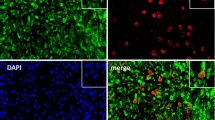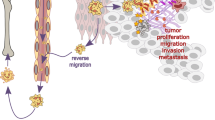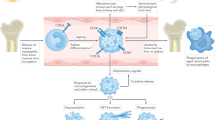Abstract
Gout is characterized by an acute inflammatory reaction and the accumulation of neutrophils in response to monosodium urate (MSU) crystals. Inflammation resolves spontaneously within a few days, although MSU crystals can still be detected in the synovial fluid and affected tissues. Here we report that neutrophils recruited to sites of inflammation undergo oxidative burst and form neutrophil extracellular traps (NETs). Under high neutrophil densities, these NETs aggregate and degrade cytokines and chemokines via serine proteases. Tophi, the pathognomonic structures of chronic gout, share characteristics with aggregated NETs, and MSU crystals can induce NETosis and aggregation of NETs. In individuals with impaired NETosis, MSU crystals induce uncontrolled production of inflammatory mediators from neutrophils and persistent inflammation. Furthermore, in models of neutrophilic inflammation, NETosis-deficient mice develop exacerbated and chronic disease that can be reduced by adoptive transfer of aggregated NETs. These findings suggest that aggregated NETs promote the resolution of neutrophilic inflammation by degrading cytokines and chemokines and disrupting neutrophil recruitment and activation.
This is a preview of subscription content, access via your institution
Access options
Subscribe to this journal
Receive 12 print issues and online access
$209.00 per year
only $17.42 per issue
Buy this article
- Purchase on Springer Link
- Instant access to full article PDF
Prices may be subject to local taxes which are calculated during checkout





Similar content being viewed by others
References
Brinkmann, V. et al. Neutrophil extracellular traps kill bacteria. Science 303, 1532–1535 (2004).
Urban, C.F., Reichard, U., Brinkmann, V. & Zychlinsky, A. Neutrophil extracellular traps capture and kill Candida albicans yeast and hyphal forms. Cell. Microbiol. 8, 668–676 (2006).
Yipp, B.G. et al. Infection-induced NETosis is a dynamic process involving neutrophil multitasking in vivo. Nat. Med. 18, 1386–1393 (2012).
Fuchs, T.A. et al. Novel cell death program leads to neutrophil extracellular traps. J. Cell Biol. 176, 231–241 (2007).
Schorn, C. et al. Bonding the foe—NETting neutrophils immobilize the pro-inflammatory monosodium urate crystals. Front. Immunol. 3, 376 (2012).
Akong-Moore, K., Chow, O.A., von Kockritz-Blickwede, M. & Nizet, V. Influences of chloride and hypochlorite on neutrophil extracellular trap formation. PLoS ONE 7, e42984 (2012).
Papayannopoulos, V., Metzler, K.D., Hakkim, A. & Zychlinsky, A. Neutrophil elastase and myeloperoxidase regulate the formation of neutrophil extracellular traps. J. Cell Biol. 191, 677–691 (2010).
Wu, X.W., Lee, C.C., Muzny, D.M. & Caskey, C.T. Urate oxidase: primary structure and evolutionary implications. Proc. Natl. Acad. Sci. USA 86, 9412–9416 (1989).
Shi, Y., Evans, J.E. & Rock, K.L. Molecular identification of a danger signal that alerts the immune system to dying cells. Nature 425, 516–521 (2003).
So, A. Neue erkenntnisse zur pathophysiologie und therapie der gicht. Z. Rheumatol. 66, 562–567 (2007).
Martinon, F., Petrilli, V., Mayor, A., Tardivel, A. & Tschopp, J. Gout-associated uric acid crystals activate the NALP3 inflammasome. Nature 440, 237–241 (2006).
Schorn, C. et al. Sodium overload and water influx activate the NALP3 inflammasome. J. Biol. Chem. 286, 35–41 (2011).
Kasama, T. et al. Neutrophil-derived cytokines: potential therapeutic targets in inflammation. Curr. Drug Targets Inflamm. Allergy 4, 273–279 (2005).
Ryckman, C. et al. Monosodium urate monohydrate crystals induce the release of the proinflammatory protein S100A8/A9 from neutrophils. J. Leukoc. Biol. 76, 433–440 (2004).
Schorn, C. et al. The uptake by blood-borne phagocytes of monosodium urate is dependent on heat-labile serum factor(s) and divalent cations. Autoimmunity 43, 236–238 (2010).
Scanu, A. et al. Cytokine levels in human synovial fluid during the different stages of acute gout: role of transforming growth factor β1 in the resolution phase. Ann. Rheum. Dis. 71, 621–624 (2012).
Urban, C.F. et al. Neutrophil extracellular traps contain calprotectin, a cytosolic protein complex involved in host defense against Candida albicans. PLoS Pathog. 5, e1000639 (2009).
Choi, H.K. et al. Dual energy computed tomography in tophaceous gout. Ann. Rheum. Dis. 68, 1609–1612 (2009).
Manger, B., Lell, M., Wacker, J., Schett, G. & Rech, J. Detection of periarticular urate deposits with dual energy CT in patients with acute gouty arthritis. Ann. Rheum. Dis. 71, 470–472 (2012).
Hakkim, A. et al. Activation of the Raf-MEK-ERK pathway is required for neutrophil extracellular trap formation. Nat. Chem. Biol. 7, 75–77 (2011).
Brinkmann, V. & Zychlinsky, A. Beneficial suicide: why neutrophils die to make NETs. Nat. Rev. Microbiol. 5, 577–582 (2007).
Shah, K., Spear, J., Nathanson, L.A., McCauley, J. & Edlow, J.A. Does the presence of crystal arthritis rule out septic arthritis? J. Emerg. Med. 32, 23–26 (2007).
Beyer, C. & Pisetsky, D.S. Modeling nuclear molecule release during in vitro cell death. Autoimmunity 46, 298–301 (2013).
Hultqvist, M. et al. Enhanced autoimmunity, arthritis, and encephalomyelitis in mice with a reduced oxidative burst due to a mutation in the Ncf1 gene. Proc. Natl. Acad. Sci. USA 101, 12646–12651 (2004).
Sareila, O., Jaakkola, N., Olofsson, P., Kelkka, T. & Holmdahl, R. Identification of a region in p47phox/NCF1 crucial for phagocytic NADPH oxidase (NOX2) activation. J. Leukoc. Biol. 93, 427–435 (2013).
Remijsen, Q. et al. Neutrophil extracellular trap cell death requires both autophagy and superoxide generation. Cell Res. 21, 290–304 (2011).
Savill, J., Dransfield, I., Gregory, C. & Haslett, C. A blast from the past: clearance of apoptotic cells regulates immune responses. Nat. Rev. Immunol. 2, 965–975 (2002).
Papayannopoulos, V. & Zychlinsky, A. NETs: a new strategy for using old weapons. Trends Immunol. 30, 513–521 (2009).
Mitroulis, I. et al. Neutrophil extracellular trap formation is associated with IL-1β and autophagy-related signaling in gout. PLoS ONE 6, e29318 (2011).
Keshari, R.S. et al. Neutrophil extracellular traps contain mitochondrial as well as nuclear DNA and exhibit inflammatory potential. Cytometry A 81, 238–247 (2012).
Pascual, E., Batlle-Gualda, E., Martinez, A., Rosas, J. & Vela, P. Synovial fluid analysis for diagnosis of intercritical gout. Ann. Intern. Med. 131, 756–759 (1999).
Bournazou, I. et al. Apoptotic human cells inhibit migration of granulocytes via release of lactoferrin. J. Clin. Invest. 119, 20–32 (2009).
Elliott, M.R. et al. Nucleotides released by apoptotic cells act as a find-me signal to promote phagocytic clearance. Nature 461, 282–286 (2009).
Gresnigt, M.S. et al. Neutrophil-mediated inhibition of proinflammatory cytokine responses. J. Immunol. 189, 4806–4815 (2012).
Olofsson, P. et al. Positional identification of Ncf1 as a gene that regulates arthritis severity in rats. Nat. Genet. 33, 25–32 (2003).
Campbell, A.M., Kashgarian, M. & Shlomchik, M.J. NADPH oxidase inhibits the pathogenesis of systemic lupus erythematosus. Sci. Transl. Med. 4, 157ra141 (2012).
Jacob, C.O. et al. Lupus-associated causal mutation in neutrophil cytosolic factor 2 (NCF2) brings unique insights to the structure and function of NADPH oxidase. Proc. Natl. Acad. Sci. USA 109, E59–E67 (2012).
Nilsson, C. et al. Optimal blood mononuclear cell isolation procedures for γ interferon enzyme-linked immunospot testing of healthy Swedish and Tanzanian subjects. Clin. Vaccine Immunol. 15, 585–589 (2008).
Huang, C.K., Zhan, L., Hannigan, M.O., Ai, Y. & Leto, T.L. P47(phox)-deficient NADPH oxidase defect in neutrophils of diabetic mouse strains, C57BL/6J-m db/db and db/+. J. Leukoc. Biol. 67, 210–215 (2000).
Cinel, I. et al. Involvement of Rho kinase (ROCK) in sepsis-induced acute lung injury. J. Thorac. Dis. 4, 30–39 (2012).
Cadène, M. et al. Inhibition of neutrophil serine proteinases by suramin. J. Biol. Chem. 272, 9950–9955 (1997).
Iwata, K. et al. Effect of neutrophil elastase inhibitor (sivelestat sodium) in the treatment of acute lung injury (ALI) and acute respiratory distress syndrome (ARDS): a systematic review and meta-analysis. Intern. Med. 49, 2423–2432 (2010).
Schaertl, S. et al. A profiling platform for the characterization of transglutaminase 2 (TG2) inhibitors. J. Biomol. Screen. 15, 478–487 (2010).
Wiedow, O., Schroder, J.M., Gregory, H., Young, J.A. & Christophers, E. Elafin: an elastase-specific inhibitor of human skin. Purification, characterization, and complete amino acid sequence. J. Biol. Chem. 265, 14791–14795 (1990).
Acknowledgements
This project was supported by the Interdisciplinary Center for Clinical Research (IZKF) at the University Hospital of the University of Erlangen-Nuremberg, projects A41 and J41 (C.S., L.E.M. and Martin Herrmann), the Masterswitch project of the European Union (G.S. and Martin Herrmann), SPP1468-IMMUNOBONE (Markus Hoffmann and Martin Herrmann), SFB 643 (L.E.M.), training grant GK SFB 643 from the Deutsche Forschungsgemeinschaft (DFG) (C.S. and C.J.), the Emerging Fields Initiative (EFI) of the Friedrich-Alexander-Universität (FAU) Erlangen-Nuremberg (L.E.M.) and the K. und R. Wucherpfennigstiftung (Martin Herrmann). E.N. was supported by the Deutsche Krebshilfe AZ 109510. B.F. was supported by the European Commissions (DoReMi, European Network of Excellence, contract number 249689) and the German Research Foundation (GA 1507/1-1). R.H. was supported by the Swedish Science Strategic foundation and the EU FP7 project Neurinox. Markus Hoffmann was funded by the Austrian Science Fund FWF (project J3102-B13). We thank K. Wing, Karolinska Institutet, for genotyping of mice.
Author information
Authors and Affiliations
Contributions
C.S. planned and performed most of the in vitro and in vivo experiments, conducted data analysis and wrote the manuscript. C.J., L.E.M., B.F., Y.Z., D.K., I.J. and R.B. performed in vivo and in vitro experiments and conducted data analyses. R.H. provided the Ncf1** mice and discussed the strategy of the experiments. M.L., B.M. and J.R. arranged and conducted the DECT analyses. E.N. performed and evaluated immune histology. T.H. and V.K. contributed samples from patients with CGD or gout and controls and provided scientific input. B.M., R.H., L.E.M. and G.S. provided scientific input and wrote the manuscript. Markus Hoffmann planned the experiments, provided scientific input and wrote the manuscript. Martin Herrmann supervised the project, planned and conducted experiments and data analysis and wrote the manuscript. All authors read and approved the manuscript.
Corresponding author
Ethics declarations
Competing interests
The authors declare no competing financial interests.
Supplementary information
Supplementary Text and Figures
Supplementary Figures 1–13 (PDF 2140 kb)
Generation of NETs by neutrophils
Isolated human neutrophils (5 × 106 cells ml-1) were stained with Hoechst 33342, incubated with monosodium urate crystals, and analyzed by timelapse video microscopy. Arrows show neutrophils rearranging their internal structures and finally forming NETs in a rapid disintegration process. The original length of the video is 70 minutes. (AVI 332 kb)
Untreated isolated human neutrophils do not undergo NETosis
Isolated human neutrophils (5 × 106 cells ml-1) were stained with Hoechst 33342, incubated with PBS as control, and analyzed by time-lapse video microscopy. The original length of the video is 70 minutes. (AVI 351 kb)
Rights and permissions
About this article
Cite this article
Schauer, C., Janko, C., Munoz, L. et al. Aggregated neutrophil extracellular traps limit inflammation by degrading cytokines and chemokines. Nat Med 20, 511–517 (2014). https://doi.org/10.1038/nm.3547
Received:
Accepted:
Published:
Issue Date:
DOI: https://doi.org/10.1038/nm.3547
This article is cited by
-
Proteomic analysis of sialoliths from calcified, lipid and mixed groups as a source of potential biomarkers of deposit formation in the salivary glands
Clinical Proteomics (2023)
-
Transient receptor potential melastatin 2 regulates neutrophil extracellular traps formation and delays resolution of neutrophil-driven sterile inflammation
Journal of Inflammation (2023)
-
Neutrophil extracellular traps aggravate neuronal endoplasmic reticulum stress and apoptosis via TLR9 after traumatic brain injury
Cell Death & Disease (2023)
-
Neutrophil extracellular traps in intracerebral hemorrhage: implications for pathogenesis and therapeutic targets
Metabolic Brain Disease (2023)
-
Silver doping of clinoptilolite particles enhances their effects on immunocompetent mammalian cells and inhibition of Candida albicans fungi
Applied Nanoscience (2023)



